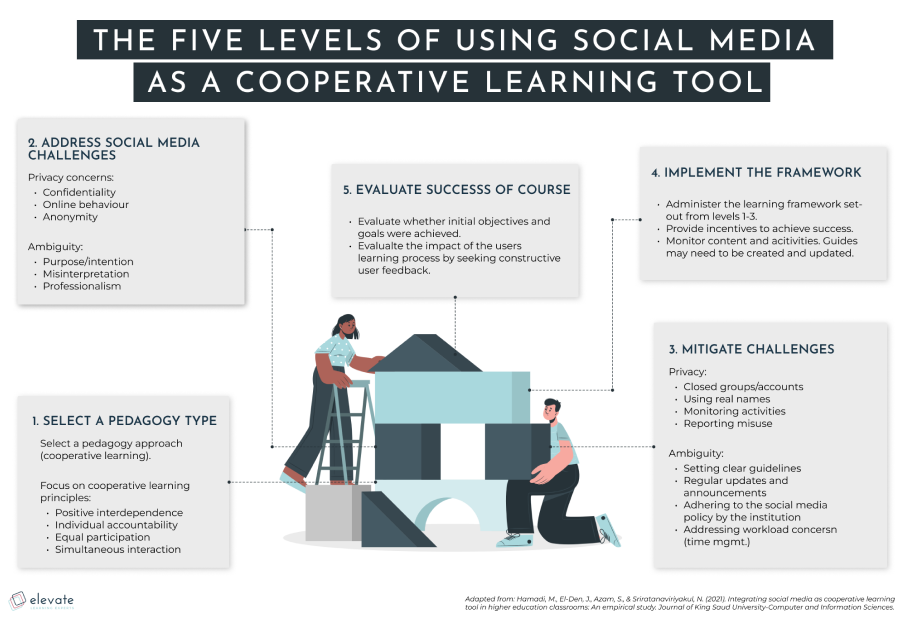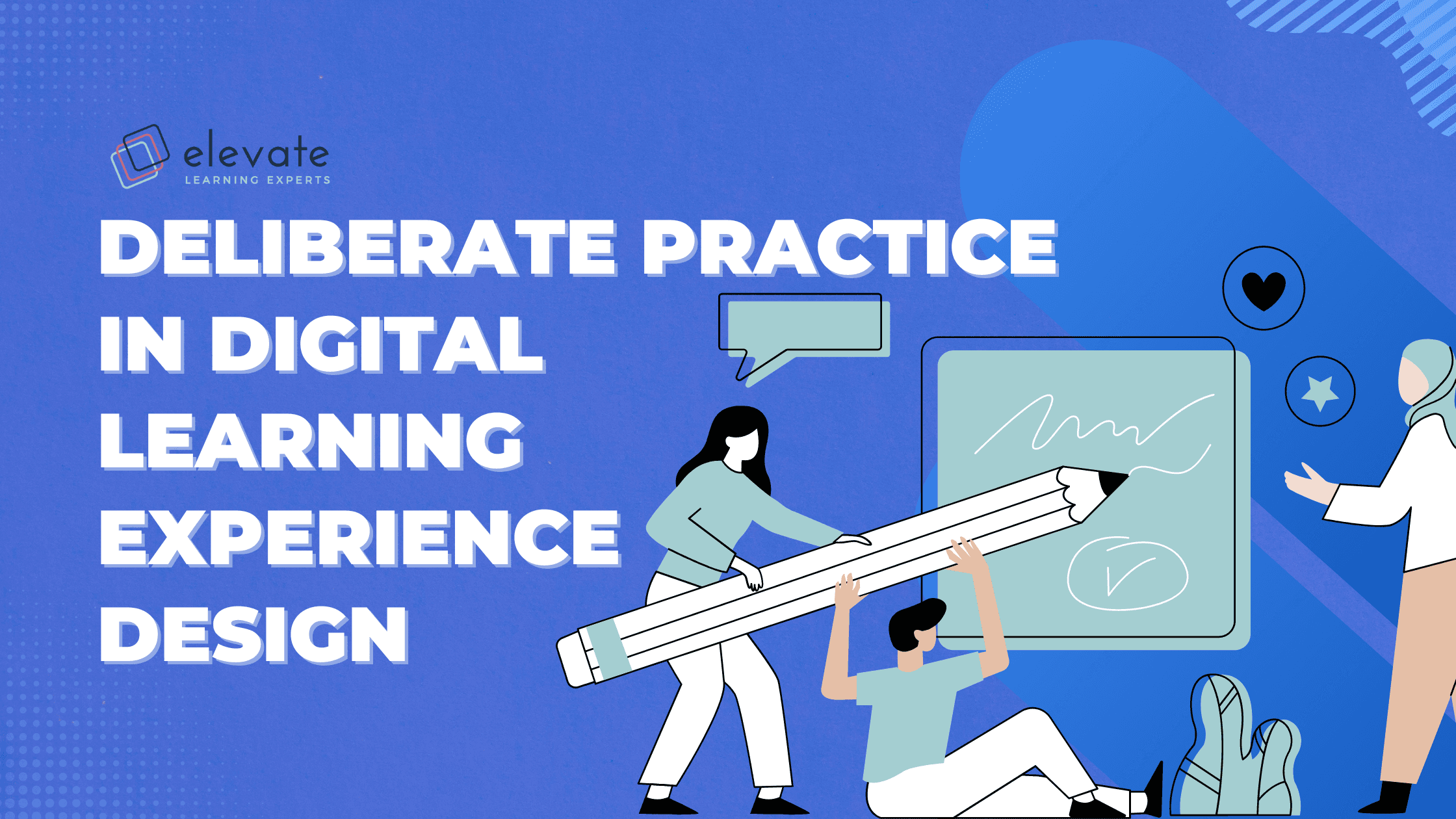Long before the COVID-19 outbreak, individuals across the world were using social media as a tool to create community, to foster collaboration, and to broadcast information for consumption. Social media has become an intrinsic part of daily life, with studies claiming that users spend an average of 2 hours and 24 minutes a day on different platforms. Since the COVID-19 outbreak, pockets of society have become increasingly dependent on social media as a means of information gathering and a means of forging and strengthening collaborative spaces.
The Role of Social Media Tactics in eLearning
By its very nature, the digital world is continually developing, growing and adapting. The social media platforms which occupy this space equally adapt to meet its users’ changing demands and needs. However, one use of social media remains unchanged: social networking.

Social learning is a key motivating factor for many in-person learning experiences. The growing demand to take learning online whilst ensuring that the social needs of learners are met has left many scratching their heads as to how to achieve this. But it’s the same platforms we’ve long been using to engage with others online that can also be utilised as a cooperative learning tool.

With more than half the world’s population having some sort of social media account, it is increasingly becoming evident that institutions seeking to disseminate learning material, have not only a wide audience base, but one that is ready to consume information online.
So, how can we start to shift our perceptions of social media away from simply documenting lifestyles and selling products or services, to one that positions social media as a platform for collaborative and cooperative learning?
The Importance of Harnessing Social Media as a Learning Tool
Your learners’ digital footprint is present now more than ever. Access to information is now more readily available at a simple click of a button, which leaves learners hungry to learn more, instantly.
In 2021, Hamadi, El-Den, Azam and Sriratanaviriyakul published a framework for integrating social media as a cooperation learning tool — assessing the pedagogical benefits of social media platforms and tactics. This valuable research was conducted with higher education in mind, but could potentially be applied to other learning contexts too.
If implemented carefully, the use of social media in the learning process could enhance users’ collaboration, communication, and engagement. These learning platforms could allow for in-class learning and offline activities — simultaneously addressing users’ needs and learning goals.
Their proposed framework is made up of five levels which are followed sequentially:

This framework identifies valuable considerations for any learning environment or design:
- The correct pedagogical approach must be carefully selected (in this instance, we’re focusing on cooperative learning as an effective approach).
- Common challenges and fears surrounding the use of social media must not be ignored, and should rather be factored into both the design and implementation of a learning plan.
- After selecting your pedagogical approach, identifying key challenges, and designing a solution to mitigate these concerns, you can begin to implement your learning plan. This may look different based on the nature of delivery – whether you’re online or in-person – but regardless, your learners should feel empowered and motivated by this plan.
- Finally, after you have delivered this plan learning, take time to properly evaluate the success (or failings) of this plan. Engage directly with learners and seek out feedback.
While the purpose of this article is not to describe the five levels of the original work, it is of importance to explore some of the key points from this framework as they align with various social media tactics and platforms within the eLearning space.

Role in eLearning
Each social media platform is unique, has a specific purpose, and is effective in specific contexts and settings. So, it is vital to consider the characteristics or built-in features of various social media platforms in order to enhance the desired teaching approach.
An important part of the eLearning process is identifying the correct learning platforms to deliver your learning experience. The same can be said for any tools or platforms you wish to integrate into your online platform, or embed into the content delivery strategy. During the online platform selection process, you would have identified the following criteria:
- Who your learner is, and their comfort level with technology;
- How learners will access the learning content;
- The learning approach (synchronous, asynchronous, blended);
- Whether the learning journey is linear, non-linear or semi-linear; and
- The available budget, etc.
These are all crucial factors to consider when choosing tools and platforms that will be integrated into the learning experience. Your goal is to ensure that the learner succeeds, and the chosen social media platform should not hinder this success; rather it should enhance their experience and performance.
Social Media Tactic
Let’s consider Instagram, a social media platform where information is shared by uploading videos and photos, as an example of a cooperative learning tool:
In the examples below, each Instagram account has been set up with the purpose of helping their followers learn and improve their English skills.

This method of learning offers learners the opportunity to exercise independent study within their timeframe. Learning time is a key consideration for any course or programme, especially given the increasing time-stress being placed on our learners.
It is vital that learning designers, instructors, and educators understand how to create positive interdependence, promote interaction, and group processing into the social media learning environment. Our goal as educators should be to foster an environment where learners are active participants in their learning journey — with an aim of developing an ethos of lifelong learning.

Role in eLearning
Anxiety surrounding concerns of privacy, security and ambiguity should be used to analyse the use of a particular social media platform as a tool for cooperative learning.
Privacy and ambiguity are two of the greatest challenges when it comes to implementing social media as a learning tool. Institutions must validate these concerns by implementing measures to mitigate against these concerns for their learners.
Social Media Tactics
Addressing privacy requires a focus on confidentiality, online behaviour, anonymity as well as control and monitoring. Confidentiality could be minimised by utilising the personal privacy options that are available on many social media platforms. In most cases, instructors are given the option to add a private page or profile that when used can only be accessed by specific learners.
In addition, anonymity can be addressed by allowing every learner access to the learning platform only if their real-life names are utilised. To limit the misuse and misconduct by users on the selected platform, measures should be put into place and monitored regularly. For example, using closed groups where only approved learners have access and misconduct is reported if observed. These groups need to be supervised by either the instructor involved or selected learners.
When dealing with ambiguity, three aspects must be considered: purpose, professionalism, and workload concerns. Remember that learners may not always be aware of the intended purpose of the implemented social media learning activity, so it’s important to provide learners with clear guidelines and expectations on how to access and use the platforms for educational purposes. These guidelines should address crucial aspects such as professionalism to guarantee that there are no misunderstandings about conduct while learning.
Furthermore, learners may experience workload concerns associated with multitasking, distractions and time management when using social media platforms. Instructors should help learners navigate these concerns by bringing awareness to these potential roadblocks, ensuring that learning isn’t negatively influenced.

Role in eLearning
For the implementation of social media as a cooperative learning tool to be a success, incentives need to be provided, and a reward system can influence the user’s level of engagement and participation in learning.
Social media should be viewed as an interactive online learning resource between learners as well as instructors. The content posted, shared, or created should be managed according to the learning material and time set for each unit. Instructors, therefore, guide activities and provide learning support where required. Prepare a list of social media activities incorporating their teaching methods but keeping in mind what the social media platform offers in terms of features.
Social Media Tactics
Encouraging learner participation and engagement through the use of the comment feature available on many social media platforms, can help foster a greater sense of community. Despite our desire to be a part of a community, our learners are often not properly incentivised to participate in online discussions. Let’s briefly consider YouTube as a discussion tool.
Not only can YouTube be utilised as a powerful tool for enhancing content mastery through visual cues, but its comment features allow for learners to engage with fellow learners by replying to comments which may spark interest. Use prompts at the end of your videos asking learners to share their personal insights — What stood out to them? What challenged their perceptions towards the topic or concept? Then, take it one step further by encouraging learners to interact with other comments. As an instructor, a rubric could be developed to assess the quality of the posts, as well as the learner-to-learner engagement.

Role in eLearning
While an initial analysis would have taken place to identify which social media platform is fit-for-purpose for your needs, gathering learner data about their experiences and engagement with the platform will prove valuable. Evaluate the impact of the learning process by seeking constructive feedback and reflections from learners throughout the process or when the course is completed. If engagement and interest levels are low, then perhaps the initial fit-for-purpose assessment missed the mark. Find out from your learners what qualities they deem as necessary to increase engagement and interest in this learning tactic.
Social Media Tactics
Since our learners typically are already overburdened with work and life demands, requesting that they complete a lengthy survey, may not produce the results necessary to proper tool evaluation. Crafting strategic survey questions can be powerful for gathering the required learner feedback on teaching methodologies and their engagement with particular tools and platforms.
Social media platforms, like LinkedIn, provide in-built polling software that can not only help in promoting a community through engagement, but can also assist in the data gathering process. With these polls, you can engage with your learners, promote conversation, encourage reflection, and assess your learning strategies and social media tactics.
Towards an Integrated Future of Digital Learning
We are naturally pulled towards spaces and environments that foster collaboration and community. As we have seen through these key points, the same sentiment can be said for the e-learning environment. Social media should have a place in the education process as its very nature promotes cooperative learning, but be sure to utilise the social media platforms which your learners engage with the most in order to move away from the more traditional and outdated way of creating learning. This allows users to share information and be engaged and motivated to work in a more enjoyable environment.
There is an immeasurable amount of information and knowledge desired to be shared, so instructors and educators should take advantage of the features that the current generation of social media has to offer, as well as be at the forefront of education-based developments within social media platforms.
References
Alenazy, W. M., Al-Rahmi, W. M., & Khan, M. S. (2019). Validation of TAM model on social media use for collaborative learning to enhance collaborative authoring. Ieee Access, 7, 71550-71562.
Arshavskiy, M. (2021). Social Media For eLearning. eLearning Industry. Retrieved 6 May 2022, from https://elearningindustry.com/social-media-for-elearning.
Average Time Spent Daily on Social Media (Latest 2022 Data), (2022). BroadbandSearch. Retrieved from https://www.broadbandsearch.net/blog/average-daily-time-on-social-media#post-navigation-1.
Bauld, A. (2021). My Get Up and Go Got Up and Went. Harvard Ed. Magazine. Retrieved 6 May 2022, from https://www.gse.harvard.edu/news/ed/21/05/my-get-and-go-got-and-went.
Buckler, L. Teach, Learn, Share: the Role of Social Media in eLearning. Shiftelearning.com. Retrieved 6 May 2022, from https://www.shiftelearning.com/blog/teach-learn-share-the-role-of-social-media-in-elearning.
Hamadi, M., El-Den, J., Azam, S., & Sriratanaviriyakul, N. (2021). Integrating social media as cooperative learning tool in higher education classrooms: An empirical study. Journal of King Saud University-Computer and Information Sciences.

